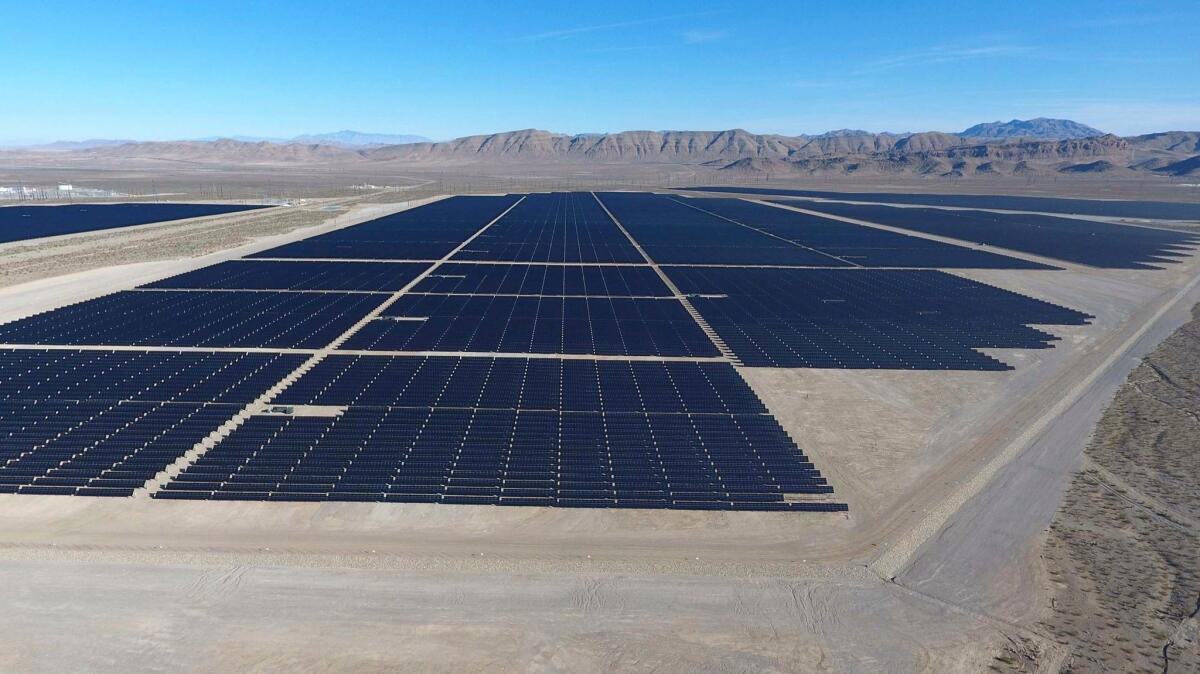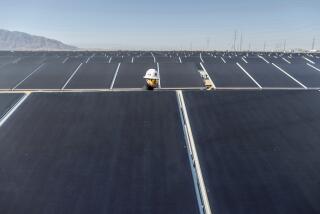As Trump’s fossil-fuel ‘energy dominance’ plan founders, a crucial solar energy decision nears

During his first year in office, President Trump has guided the nation’s energy course directly into the headwinds of market instability, civic opposition, unstable finance and environmental risk in order to fortify the domestic coal and oil industries.
But this week, the administration’s plan to achieve what it termed “American energy dominance” has foundered amid obstacles of law, economy, technology and political miscalculation.
On Monday, the Federal Energy Regulatory Commission swept aside as ill-advised and unlawful a proposal by Energy Secretary Rick Perry to subsidize old coal and nuclear power plants to keep them operating.
The next day, Interior Secretary Ryan Zinke dismissed Florida from his mammoth offshore oil drilling plan, opening to court challenge from other coastal states the legal legitimacy of a proposal that just five days before he promised would make America “the strongest energy superpower.”
Trump has big plans for offshore oil development. But will it ever happen? »
Both setbacks came as a new report by the Energy Information Administration, a research unit of the Energy Department, projected that utilities were preparing this year to shut down a near-record number of old coal-fired power plants. A coal mine operator announced a closure in Pennsylvania that would end 400 jobs. And oil and gas lease auctions on public lands in Alaska and across the West attracted weak interest from exploration companies.
This wasn’t the goal.
Unlike China, Europe and India, which are pivoting to renewable energy and away from coal and oil for economic and environmental reasons, Trump and his aides have focused on making the fuels that ruled the 20th century economically relevant again. He has withdrawn the United States from the Paris climate treaty. He signed one executive order to dismantle President Obama’s program to reduce carbon emissions from coal-fired power plants, and a second to curb “regulatory burdens that unnecessarily encumber energy production.”
Just last week, the administration, under Zinke’s plan, proposed to open almost all of the outer continental shelf to offshore energy exploration.
Environmental groups have delighted in watching the administration’s fossil-energy campaign founder, and California and other coastal state leaders have called on Zinke to remove their states from the offshore drilling plan.
At the same time, though, one more momentous decision for energy, the economy and the environment awaits the president.
Sometime before Jan. 26, Trump will rule on levying a tariff on imported crystalline photovoltaic panels, by far the most popular equipment in the U.S. for generating electricity from the sun.
In October, the U.S International Trade Commission recommended levying tariffs on solar cells and panels of up to 35%. The president has full authority to follow that recommendation, opt for his own remedies or not to act at all. Industry executives warn that a high tariff would injure American competitiveness in renewable energy, one of the largest job-producing industrial sectors of the 21st century.
“It would be very disruptive,” said Mark Marion, a senior vice president at Juwi Americas, a developer of utility-scale solar power stations, based in Boulder, Colo. “It’s like driving a car fast and slamming on the brakes.”
The president’s decision on solar tariffs marks a clearly defined pivot point for the United States, one defined by powerful and converging trends in economics and the environment that the president has resisted. But other powerful nations have embraced the converging trends and pointed themselves in a new direction.
In the United States, the world’s second-largest producer, domestic coal consumption continues to slip, and production is 35% lower than its peak in 2008, according to the U.S. Energy Information Administration. The United States now generates 30% of its electricity with coal, down from more than 50% a decade ago.
Coal markets in China and India also are getting softer as both countries close coal-fired power plants. China, the world’s largest coal producer and consumer, has canceled 300 coal-fired power plants in the last two years. In India, too, coal production is flattening.
Oil markets also are erratic. Consumption in the U.S. is more than 1 million barrels a day less than it was in 2005, and it is leveling off globally.
The downturn in both sectors, along with the threat of carbon-influenced climate change, has caused utilities and oil companies in the U.S. and around the world to encounter new impediments in financing their work. Oil company stock prices are well below their 2007 peaks. The Norwegian sovereign wealth fund, the World Bank, pension funds and other big financial institutions have announced they will not fund new fossil fuel projects.
On Wednesday, New York Mayor Bill de Blasio announced that in the next five years he and the city comptroller planned to divest the $5 billion in fossil fuel holdings from the city’s $189-billion pension fund. “We’re bringing the fight against climate change straight to the fossil fuel companies,” De Blasio said in a statement.
As fossil energy has turned down, investments in renewable energy are rising fast. The U.S. solar sector has grown to about 40 manufacturing plants, over 9,000 installation companies and 260,000 employees, according to the Solar Energy Industries Assn., the industry’s major trade group in Washington. (By contrast, 53,420 people work in the coal industry, according to the Bureau of Labor Statistics.)
New and cleaner fuel sources are becoming mainstream. Electric plants that rely on wind, solar and small hydropower dams are easier and cheaper to build and operate, engineers and utility executives say. Investments worldwide in new generating capacity from wind and solar energy reached $286 billion in 2015, twice as much as investments in fossil-fuel-generated electricity, according to a study by the United Nations Environment Program.
ALSO
China’s heralded ‘solar highway’ closed after thieves stole one of the panels
Trump plan to expand oil and gas leasing in West draws, for the most part, a big yawn from industry
Times staff writer Nina Agrawal in New York contributed to this report.
More to Read
Sign up for Essential California
The most important California stories and recommendations in your inbox every morning.
You may occasionally receive promotional content from the Los Angeles Times.






